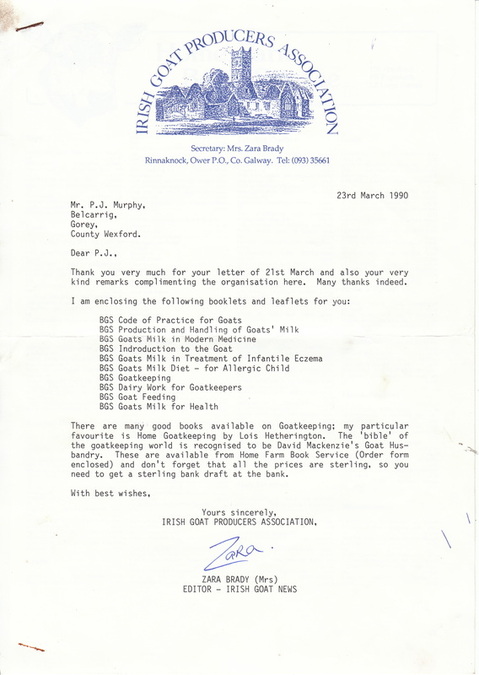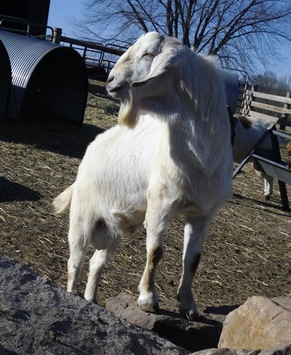Starting to learn about meat goats
In 1989, in County Wexford, Ireland, I kept my first goats. I bred kids for slaughter and joined the only goat group around. Most people who kept goats did so for milk but readily eat the male kids they had, (or others ate them for them!!).
On this page, I would like to outline some of my early interest in goats, my livestock breeding background and comment on the goats I've had at my farm.
On this page, I would like to outline some of my early interest in goats, my livestock breeding background and comment on the goats I've had at my farm.
Irish Goat News: Member publication of the "Irish Goat Producers Association".

This is a copy of "Irish Goat News" from September, 1989 when I was a member of the "Irish Goat Producers Association". The association was affiliated with the "British Goat Society".
This publication was edited and produced by Zara Brady and was filled with informative goat articles and news about the small world of Irish Goat Breeding. At the time, I was searching for information on goats. Information was more readily available on sheep in Ireland at the time but after leafing through the copies of the News that I still have, I can say that there were many articles which would be useful to many in the American goat production business.
This edition addressed:
Flushing for increased prolificacy,
Breeding for longevity,
Enterotoxemia,
Chevon Meat Cuts
and a discussion of management for the control of internal parasites.
"The more things change, the more they stay the same."
This publication was edited and produced by Zara Brady and was filled with informative goat articles and news about the small world of Irish Goat Breeding. At the time, I was searching for information on goats. Information was more readily available on sheep in Ireland at the time but after leafing through the copies of the News that I still have, I can say that there were many articles which would be useful to many in the American goat production business.
This edition addressed:
Flushing for increased prolificacy,
Breeding for longevity,
Enterotoxemia,
Chevon Meat Cuts
and a discussion of management for the control of internal parasites.
"The more things change, the more they stay the same."
Goat Feeding
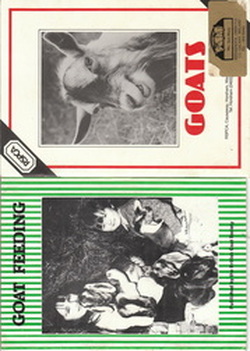
In 1989, I had a hard time finding good goat feeding and husbandry information and found booklets produced mostly in Great Britain to be very informative and helpful. Being a dairy animal, much study had been conducted about goats, and the art of feeding them very productively had been finely honed.
"Goat Feeding" shown here with "Goats" from the RSPCA, was detailed book with advice specific to different ages and types of goats.
"Goat Feeding" shown here with "Goats" from the RSPCA, was detailed book with advice specific to different ages and types of goats.
Looking for more goat information. March, 1990
Newly Freshened Yearling

Wexford, Ireland. 1990. I bred the goats early and, if they were managed correctly, they could manage it. These goats gave me the impression that a goat could be hardy. They had to be.
I later experimented with full blood dairy goats and found that the feral-cross type I had experience with earlier were more hardy. They were not very productive, however. Little selection for prolificacy or ADG meant mediocre results from the kids for meat production.
I later experimented with full blood dairy goats and found that the feral-cross type I had experience with earlier were more hardy. They were not very productive, however. Little selection for prolificacy or ADG meant mediocre results from the kids for meat production.
Irish Draught and Irish Sport Horse Breeding Backround

My father still breeds Irish Draught Horses and their Thoroughbred Cross-Bred progeny - which are referred to as "Irish Sport Horses". The Irish-Sport-Horses then were comprised of various levels of Irish Draught and Irish Thoroughbred crossed - and in more recent times European "Warm" Bloods.
The breeding of the Purebred Draughts (which in reality are a more athletic horse than a true draught horse) demands a different focus and set of breeding criteria than does the production of the more sporty and high energy, but higher maintenance, Irish Sport Horse.
My Father, Aidan Murphy Sr., is pictured here with a Prize Winning Foal he showed in the 90's. The foal was bred from an Irish Draught mare that he also bred. She was one of the highest rated Irish Draught mares in the Ireland at the Registry approval inspections when she was approved for full registry.
The breeding of the Purebred Draughts (which in reality are a more athletic horse than a true draught horse) demands a different focus and set of breeding criteria than does the production of the more sporty and high energy, but higher maintenance, Irish Sport Horse.
My Father, Aidan Murphy Sr., is pictured here with a Prize Winning Foal he showed in the 90's. The foal was bred from an Irish Draught mare that he also bred. She was one of the highest rated Irish Draught mares in the Ireland at the Registry approval inspections when she was approved for full registry.
Pedigree (Purebred) Sheep Breeding Family

Through the 90's and continuing until today, my family breeds pedigree sheep and enjoyed much success with them. The first breed to be showed were Blue Du Maines. They are a Maternal Breed with high mothering instincts, vigourous lambs and an active nature. They make excellent brood ewes and the cross-bred Blue Du Maine ewe was an excellent commercial ewe. My mother, Anne Murphy, enjoyed great success with them and showed them and judged them nationally (in Ireland) and internationally.
Pictured here is my mother with one of her early Blue Du Maines.
Pictured here is my mother with one of her early Blue Du Maines.
Breeding "Terminal Sire" Sheep - Texels
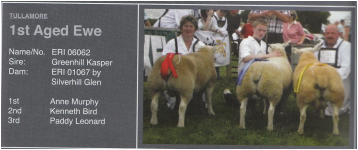
Later in the 1990's, Texel Sheep became the focus of the sheep breeding program of my family. Texel Sheep were developed in Holland.
My mother, Anne Murphy, has served as "Chairperson" of the Irish Texel Sheep Sheep Society. She also has been elected to serve as a pedigree sheep breeders (Multiple Breeds) representative to the Irish Department of Agriculture Sheep improvement program called "LambPlus". Those interested in Small Ruminant production should research the LambPlus program. The largest Central Progeny Test in the world in sheep is currently being run in Ireland.
The challenges that goat breeders in this country are faced with, are being faced by breeders accross the world. Many of the breeding and management decisions I face every year, are the same decisions that my mother faces in her sheep flock every year and so it goes for breeders of sheep and goats accross the world. The interesting thing is that, in the end, the same principles apply. Especially where sheep and goats are concerned, due to their similar life cycles and diseases and susceptibilities, much is to be learned and new perspectives gained, when discussing and comparing the two.
My mother, Anne Murphy, has served as "Chairperson" of the Irish Texel Sheep Sheep Society. She also has been elected to serve as a pedigree sheep breeders (Multiple Breeds) representative to the Irish Department of Agriculture Sheep improvement program called "LambPlus". Those interested in Small Ruminant production should research the LambPlus program. The largest Central Progeny Test in the world in sheep is currently being run in Ireland.
The challenges that goat breeders in this country are faced with, are being faced by breeders accross the world. Many of the breeding and management decisions I face every year, are the same decisions that my mother faces in her sheep flock every year and so it goes for breeders of sheep and goats accross the world. The interesting thing is that, in the end, the same principles apply. Especially where sheep and goats are concerned, due to their similar life cycles and diseases and susceptibilities, much is to be learned and new perspectives gained, when discussing and comparing the two.
Goat Breeding Hiatus
Through the nineties I completed a First Class Honors Degree in Equine Science and pursued an education in the Equine Dental business, which was experiencing a revolution at the time. I traveled and worked in France, England and eventually in California, Kentucky and Florida. I eventually settled in New Jersey and returned to breeding and producing goats as soon as I could.
The Boer Goat "Experience"
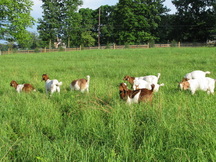
When I returned to breeding meat goats, I went with Boer Goats as a purpose-bred meat breed with excellent conformation, bone and substance. The experience soon went wrong and lack of genetic selection for farmability became apparent. I had a few good boer goats but most had varying degrees of performance related problems.
Udder issues; a propensity to have feet that did not handle wet conditions (snow exposure for 6 weeks can be challenging for feet), unenthusiastic mothering (in some lines) and kids that were not active shortly after birth (some lines) were some of the problems. An inability to cope with the heavy worm burden of the hot and very humid New Jersey summers simply led to too many problems for me. The problem stemmed from the way that I wanted to farm the goats - on pasture when grass is available in New Jersey and stored forage only when not heavily pregnant or rearing kids.
Udder issues; a propensity to have feet that did not handle wet conditions (snow exposure for 6 weeks can be challenging for feet), unenthusiastic mothering (in some lines) and kids that were not active shortly after birth (some lines) were some of the problems. An inability to cope with the heavy worm burden of the hot and very humid New Jersey summers simply led to too many problems for me. The problem stemmed from the way that I wanted to farm the goats - on pasture when grass is available in New Jersey and stored forage only when not heavily pregnant or rearing kids.
Dairy Goat/Meat Goat Crosses
Being from a dairy farm, I had seen dairy cows crossed with European meat breeds since my childhood and the resultant cattle were good cattle. We used the older type "British Friesian" dairy cows. They were not as huge or boney as the Holstein Cows ("Cloths hangers" some of the older Irish Farmers called them). The European cattle we used were Limousins and Blonde d’Aquitaines. I thought I would try to replicate that model.
The cross between the Dairy goats and Meat goats worked to some degree but both lacked the worm resistance I wanted and the dairy does lacked the physical reserve to withstand periodically poor forage conditions. Surprisingly, many of the dairy does I found had bags suitable for suckling.
The cross between the Dairy goats and Meat goats worked to some degree but both lacked the worm resistance I wanted and the dairy does lacked the physical reserve to withstand periodically poor forage conditions. Surprisingly, many of the dairy does I found had bags suitable for suckling.
Savanna Goats
Eventually only Kikos were good enough

After trying the other meat goats, I started paying for Kiko goats and found that the investment paid off in reduced labor and losses. After using Kiko Cross goats, I moving into percentages and then all purebred Kikos as the only goats I would keep.
The trouble of keeping different types of goats which can not be treated the same, pushed me to focus on the Kikos more quickly than I had even anticipated. I eventually purged the farm of all the previous goats and started with a clean slate.
"RAK Austin's Boy"
The trouble of keeping different types of goats which can not be treated the same, pushed me to focus on the Kikos more quickly than I had even anticipated. I eventually purged the farm of all the previous goats and started with a clean slate.
"RAK Austin's Boy"
Large Numbers of NZ and Purebred Kikos
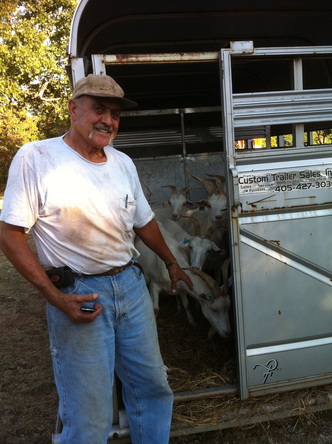
My numbers of Kikos expanded significantly when I bought out the GIN herd of the retiring Donnie Waller. I bought 64 Purebred (mostly NZ) goats from Donnie.
Donnie had started his herd from flushes from 2 heavily line bred Araroa Aristocrat and Tasman Aristocrat does. (See GIN V22 "Premier Dale" and GIN W07 - "Kiwi King"). Those does were flushed using "Cody" and "Dale" as the sires. The investment he made at that time paid off with high quality and powerful goats.
I was lucky to get them from Oklahoma all the way back to New Jersey with a 21' truck and a 16' trailer without issue. I should thank Wes Pinneo and Luke Miller for allowing me to pit stop at their homes. (I did also end up getting some "Mr. Speckles" doelings from Wes!!)
When I arrived home with the goats from that trip, it started to rain as I pulled into my yard and it rained 10 inches of rain in a tropical storm that night hitting our area. Not one goat got sick after that almost 3 days of traveling and subsequent soaking. I knew I had the goats I could work with.
Donnie Waller is pictured here on the day I picked all his goats up.
Donnie had started his herd from flushes from 2 heavily line bred Araroa Aristocrat and Tasman Aristocrat does. (See GIN V22 "Premier Dale" and GIN W07 - "Kiwi King"). Those does were flushed using "Cody" and "Dale" as the sires. The investment he made at that time paid off with high quality and powerful goats.
I was lucky to get them from Oklahoma all the way back to New Jersey with a 21' truck and a 16' trailer without issue. I should thank Wes Pinneo and Luke Miller for allowing me to pit stop at their homes. (I did also end up getting some "Mr. Speckles" doelings from Wes!!)
When I arrived home with the goats from that trip, it started to rain as I pulled into my yard and it rained 10 inches of rain in a tropical storm that night hitting our area. Not one goat got sick after that almost 3 days of traveling and subsequent soaking. I knew I had the goats I could work with.
Donnie Waller is pictured here on the day I picked all his goats up.
Kiko Industry Involvement
When we started breeding Kikos, the American Kiko Goat Association and the IKGA were the 2 Associations with registries in existence. While we initially owned goats dual registered, we had all the goats we purchased and those that we subsequently bred ourselves registered with the AKGA. We have the option to sell our goats registered - with DNA tested required as part of their pedigree verification - and buyers can register the goats with any other registry they wish. My first experience with camaraderie in the goat world was through a breeders Association and I feel it is important to support thre breed through the breed Association. As such, I got involved by volunteering to help the AKGA early in my breeding of Kiko goats.
Chair of the AKGA Performance Committee 2012-2018:
The testing of Kiko Goat had really taken off with Kikos out doing Boer and Savanna goats in the very tough Western Maryland Forage-Only (later supplementation was added in 2013 ) Test and the Oklahoma Test. At the time, the more ambitious and far sighted breeders realized that these tests could help dispel some of the negative misinformation put out by competing breeds about Kikos that they were unable to gain any weight. The Kikos showed that hey had better FEC data and very much superior worm resilience too. Of course, the tests showed that dead goats have terrible ADGs.
At the 2012 AKGA Annual Meeting, the inaugural AKGA Performance Committee was formed. I was happy to Chair that Committee and continued to do so until the AKGA 2018 Annual Convention when I decided to not continue to Chair the Committee.
During that time, I developed the AKGA Performance Test Program. That program allowed AKGA Registered Kiko Goats to be evaluated in relation to their peer grous in the various tests around the country. The program evaluated the individuals were assessed on ADG, REA and FEC - where FEC figures were available. Goats from the PA, OK, MD and WV test were entered and their performances evaluated against their peers. The system soon identified some of the superior performing families being tested across the country. After some some of uniformity in the testing protocols at different tests, the different Universities starting changing protociols and it became very difficult and eventually inmpossible to use numbers that fairly were comparable. At that stage, the program was discontinued in order to preserve the integrity of the program up to that point.
Development of the AKGA Kiko Corner Stones and Kiko Breed Guidelines:
The AKGA has not instituted a formal "Breed Standard" for the Kiko Goat. This has been done in order to allow the breed to develop with enough variation in type to allow regional and environmental adaption to occur across the United States and by extension, other countries. This allows the preservation of different types and traits within the breed and allows the breed the flexibility to adapt to the demands of the commercial market.It also helps prevent the tempatations of "Breed Standard" chasing which can lead to fads and short lived "ideals".
While the breed does not have a formal "Breed Standard" approved by the Association, it was deemed necessary to offer all breeders but especially new breeders some guidance in their evaluation of their Kiko Goats and clearly outline the traits of a good Kiko goat. As Chair of the AKGA Performance Committee (and AKGA Board Member at the same time) I set about developing a set of guidelines which would act as a guidance to current and future breeders in their breeding programs with a view to preserving highly desirable commercial traits in the Kiko Goat. This turned out to be the "Kiko Corner Stones and Breed Guidelines".
The Kiko Corner Stones are the four pillars (Hardiness, Weight, Conformation and Doe Productivity) that the breed is built on and while good growth is highly valued, maternal traits and survivability are also especially prized. To achieve "Balance" in any breed between "Maternal" and "Terminal" traits is really very difficult. That is why many breeds have focused on one path or the other. At this time (2019) the Kiko Goat offers the most complete package of meat goat characteristics available in the US. The Spanish Goat is improving as a viable second with the South African Breeds being terminal breeds. Dr Browning's TSU research showed that in real-world commercial-type settings, the Kiko Goat out-performed the other breeds and very much so out-performed the South African breeds as viable mother-goats and especially on survivability and longevity in a herd. The breed guidelines attempt to keep focus on the types of traits that make the Kiko a truly useful meat goat breed in the US meat production model.
Chair of the AKGA Performance Committee 2012-2018:
The testing of Kiko Goat had really taken off with Kikos out doing Boer and Savanna goats in the very tough Western Maryland Forage-Only (later supplementation was added in 2013 ) Test and the Oklahoma Test. At the time, the more ambitious and far sighted breeders realized that these tests could help dispel some of the negative misinformation put out by competing breeds about Kikos that they were unable to gain any weight. The Kikos showed that hey had better FEC data and very much superior worm resilience too. Of course, the tests showed that dead goats have terrible ADGs.
At the 2012 AKGA Annual Meeting, the inaugural AKGA Performance Committee was formed. I was happy to Chair that Committee and continued to do so until the AKGA 2018 Annual Convention when I decided to not continue to Chair the Committee.
During that time, I developed the AKGA Performance Test Program. That program allowed AKGA Registered Kiko Goats to be evaluated in relation to their peer grous in the various tests around the country. The program evaluated the individuals were assessed on ADG, REA and FEC - where FEC figures were available. Goats from the PA, OK, MD and WV test were entered and their performances evaluated against their peers. The system soon identified some of the superior performing families being tested across the country. After some some of uniformity in the testing protocols at different tests, the different Universities starting changing protociols and it became very difficult and eventually inmpossible to use numbers that fairly were comparable. At that stage, the program was discontinued in order to preserve the integrity of the program up to that point.
Development of the AKGA Kiko Corner Stones and Kiko Breed Guidelines:
The AKGA has not instituted a formal "Breed Standard" for the Kiko Goat. This has been done in order to allow the breed to develop with enough variation in type to allow regional and environmental adaption to occur across the United States and by extension, other countries. This allows the preservation of different types and traits within the breed and allows the breed the flexibility to adapt to the demands of the commercial market.It also helps prevent the tempatations of "Breed Standard" chasing which can lead to fads and short lived "ideals".
While the breed does not have a formal "Breed Standard" approved by the Association, it was deemed necessary to offer all breeders but especially new breeders some guidance in their evaluation of their Kiko Goats and clearly outline the traits of a good Kiko goat. As Chair of the AKGA Performance Committee (and AKGA Board Member at the same time) I set about developing a set of guidelines which would act as a guidance to current and future breeders in their breeding programs with a view to preserving highly desirable commercial traits in the Kiko Goat. This turned out to be the "Kiko Corner Stones and Breed Guidelines".
The Kiko Corner Stones are the four pillars (Hardiness, Weight, Conformation and Doe Productivity) that the breed is built on and while good growth is highly valued, maternal traits and survivability are also especially prized. To achieve "Balance" in any breed between "Maternal" and "Terminal" traits is really very difficult. That is why many breeds have focused on one path or the other. At this time (2019) the Kiko Goat offers the most complete package of meat goat characteristics available in the US. The Spanish Goat is improving as a viable second with the South African Breeds being terminal breeds. Dr Browning's TSU research showed that in real-world commercial-type settings, the Kiko Goat out-performed the other breeds and very much so out-performed the South African breeds as viable mother-goats and especially on survivability and longevity in a herd. The breed guidelines attempt to keep focus on the types of traits that make the Kiko a truly useful meat goat breed in the US meat production model.
